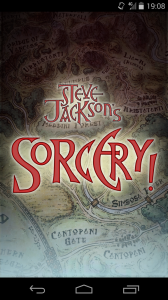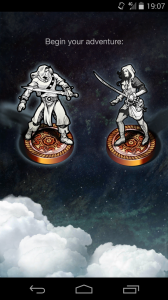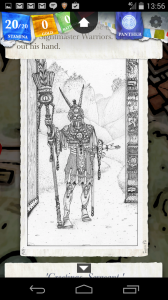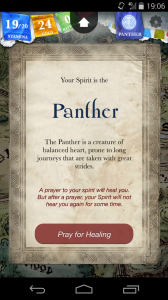 Our app guy Robb Edge pops his CH cherry with this review of Steve Jackson’s Sorcery series for iPhone and Android. Cheers, Nate
Our app guy Robb Edge pops his CH cherry with this review of Steve Jackson’s Sorcery series for iPhone and Android. Cheers, Nate
Whilst on the lookout for something new to distract me on the tube, I came across a freshly released Android app, Steve Jackson’s Sorcery! I’d been a big fan of Choose Your Own Adventure stories and had a few Fighting Fantasy books when I was a youngster, but I’d never heard of the Sorcery! series. At three quid, I figured it’d be worth investigating.
This game is actually the first of the four books in the series and is subtitled “The Shamutanti Hills”. The second, “Kharé – Cityport of Traps”, is available for iOS now with the other chapters coming soon. However, only this first installment is currently available for Android at this time.
Upon opening the game, I was presented with a choice of either a male or female character with which to begin my adventure. I tapped the male icon, a short intro played through and I was dropped into the game.
The first thing I noticed was that it looks great. The map of the game world was the first view I saw, and I could pan around it and zoom in and out as I pleased. Rather than being flat, it’s a relief map, with the peaks of mountains and troughs of valleys being revealed as I changed perspective.
My adventurer’s current location was represented by a miniature in the bottom left of the map. I tapped the miniature and and a description of the scene that he was in and the interactions that he can perform was displayed.
The narrative is revealed in small chunks played out as scenes. The text describing what is happening is displayed onscreen on parchment, and upon deciding what action to take the next section is revealed and stitched on. When the scene ends, the world map is revealed with labelled flags showing the choices for the next scene that are available.
Changing location was as simple as dragging the miniature icon to one of the flags that are available. Moving on to The Outpost Settlement, I greeted the townspeople and met with Sergeant of the guard. Doing this revealed one of the original illustrations from the book, along with the narrative. There are quite a few of these in the game, and I thought this was a really nice touch.
From here, I moved on to the training ground for a lesson in combat. Fighting happens pretty frequently and, happily, the interface for it is simple. As with narrative scenes, there is a text description of the action in the top of the screen. In the bottom half the adventurer is on the left and the opponent is on the right.
Each combatant has a measure of attack power that they can use each turn. The strength of the attack is changed by dragging the adventurer from the left to the right. The further right, the stronger the attack. After deciding how much to spend, the opponents choice is revealed. Whoever has the largest score is the winner of the round and the loser takes some damage. The amount of attack power is reduced for the next round depending on how much was spent. Attack power is restored by defending. When defending a combatant always take the minimum amount of damage from any attack. Any damage caused to either combatant is deducted from their stamina. When the stamina reaches 0, they are defeated.
A running description of course of the battle is displayed in the top section in a narrative style. This first battle I encountered was a straight tutorial, and the amount of attack power that the sergeant was going to use was called out explicitly, but for the rest of the game I had to judge what my various opponents were going to do from this description. Overall this works really well.

After defeating my first opponent, I was prompted to either Continue or Try Again. This is a mechanic akin to keeping your finger on the page when reading a book like this. After any scene, combat or otherwise, it’s possible to replay it, or to rewind to an earlier scene in the story to go for a different outcome. Personally, this doesn’t really fly with me, and I prefer to take it as it comes, good or bad.
There are a couple of other elements that are revealed in the tutorial. Buying rations, which are used to regain stamina that has been lost, and the casting spells. At first glance, casting spells seems overly complicated. The available spells are dependant upon the alignment of the stars in the current scene. Each star has a name, and the first letter of the name from three selected stars activates the spell. There are 48 documented spells in the book, and some others that may be discovered as the story progresses. Some spells are only available to cast if the adventurer has a specific item to use as a reagent. All spells have an associated stamina cost, and this is deducted whether or not the spell has a desirable outcome.
In reality its very simple. Each spell has a three letter name. ZAP for lightning, LAW for control unintelligent creature and so on. When casting, only the letters that can be currently used for each letter position in the word are shown. This actually makes it easier to decide what spell to try to use in a given situation. Tapping the spellbook icon when on the map screen will open it up and allows leafing through the pages showing the costs and effects of each spell.
In certain scenes, the opportunity to pray for assistance from the Spirit Guide is given. This may or may not have an immediate effect, or any effect at all, but the action will render any attempts to pray again in the immediate future ineffective. The Gods are fickle, I guess.
As far as the game mechanics goes, that’s about it. It’s actually a pretty short run through, and I’ve completed it twice, taking radically different paths each time. Along the way I’ve used snakes as a ladder, been given the plague, grown huge, gotten into a fight with a village full of children, fallen down a cliff and broken my neck, starved to death, been consumed by magic, had my head cut off, been boiled alive and eaten and fired a bunch of fireballs.
After reaching the end, I was able to save my game to the cloud and given a code I can use to continue in the next part with all the items and story events from any of the runs I had already completed.
Overall, this game is great and is definitely worth playing. I’ve not played the iOS version, which has had rave reviews of its own, but I’ll definitely be picking up “Kharé – Cityport of Traps” when it comes out.


Hmm. Reckon I might take a look at this. Sorcery!’s a good call for a mobile game; I remember those three-letter spells from the paper version and it’s a neat little mechanic to implement on fondleslabs. I’m liking that you have more control over your combat than just “roll good numbers lots”. Can it be – an update of Fighting Fantasy that actually improves on the original? o.o